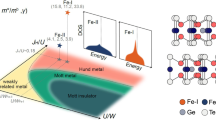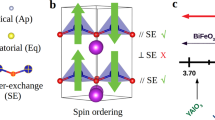Abstract
Rational material design can accelerate the discovery of materials with improved functionalities1. This approach can be implemented in Heusler compounds with tunable magnetic sublattices to demonstrate unprecedented magnetic properties2. Here, we have designed a family of Heusler alloys with a compensated ferrimagnetic state. In the vicinity of the compensation composition in Mn–Pt–Ga, a giant exchange bias (EB) of more than 3 T and a large coercivity are established. The large exchange anisotropy originates from the exchange interaction between the compensated host and ferrimagnetic clusters that arise from intrinsic anti-site disorder. Our design approach is also demonstrated on a second material with a magnetic transition above room temperature, Mn–Fe–Ga, exemplifying the universality of the concept and the feasibility of room-temperature applications. These findings may lead to the development of magneto-electronic devices and rare-earth-free exchange-biased hard magnets, where the second quadrant magnetization can be stabilized by the exchange bias.
This is a preview of subscription content, access via your institution
Access options
Subscribe to this journal
Receive 12 print issues and online access
$259.00 per year
only $21.58 per issue
Buy this article
- Purchase on Springer Link
- Instant access to full article PDF
Prices may be subject to local taxes which are calculated during checkout




Similar content being viewed by others
References
Eberhart, M. E. & Clougherty, D. P. Looking for design in materials design. Nature Mater. 3, 659–661 (2004).
Graf, T., Felser, C. & Parkin, S. S. P. Simple rules for the understanding of Heusler compounds. Prog. Solid State Chem. 39, 1–50 (2011).
Meiklejohn, W. H. & Bean, C. P. New magnetic anisotropy. Phys. Rev. 102, 1413–1414 (1956).
Nogués, J. et al. Exchange bias in nanostructures. Phys. Rep. 422, 65–117 (2005).
Skumryev, V. et al. Beating the superparamagnetic limit with exchange bias. Nature 423, 850–853 (2003).
He, X. et al. Robust isothermal electric control of exchange bias at room temperature. Nature Mater. 9, 579–585 (2010).
Wu, S. M. et al. Reversible electric control of exchange bias in a multiferroic field-effect device. Nature Mater. 9, 756–761 (2010).
Lage, E. et al. Exchange biasing of magnetoelectric composites. Nature Mater. 11, 523–529 (2012).
Gider, S., Runge, B. U., Marley, A. C. & Parkin, S. S. P. The magnetic stability of spin-dependent tunneling devices. Science 281, 797–799 (1998).
Fernandez-Outon, L. E. et al. Large exchange bias IrMn/CoFe for magnetic tunnel junctions. IEEE Trans. Magn. 44, 2824–2827 (2008).
Malozemoff, A. P. Random-field model of exchange anisotropy at rough ferromagnetic-antiferromagnetic interfaces. Phys. Rev. B 35, 3679–3682 (1987).
Kuch, W. et al. Tuning the magnetic coupling across ultrathin antiferromagnetic films by controlling atomic-scale roughness. Nature Mater. 5, 128–133 (2006).
Miltènyi, P. et al. Diluted antiferromagnets in exchange bias: Proof of the domain state model. Phys. Rev. Lett. 84, 4224–4227 (2000).
Nolting, F. et al. Direct observation of the alignment of ferromagnetic spins by antiferromagnetic spins. Nature 405, 767–769 (2000).
Takano, K., Kodama, R. H., Berkowitz, A. E., Cao, W. & Thomas, G. Interfacial uncompensated antiferromagnetic spins: Role in unidirectional anisotropy in polycrystalline Ni81Fe19/CoO bilayers. Phys. Rev. Lett. 79, 1130–1133 (1997).
Kodama, R. H., Makhlouf, S. A. & Berkowitz, A. E. Finite size effects in antiferromagnetic NiO nanoparticles. Phys. Rev. Lett. 79, 1393–1396 (1997).
Ali, M., Marrows, C. H. & Hickey, B. J. Onset of exchange bias in ultrathin antiferromagnetic layers. Phys. Rev. B 67, 172405 (2003).
Wadley, P. et al. Tetragonal phase of epitaxial room-temperature antiferromagnet CuMnAs. Nature Commun. 4, 2322 (2013).
Soh, Y. & Kummamuru, R. K. Spintronics in antiferromagnets. Phil. Trans. R. Soc. A 369, 3646–3657 (2011).
Kimel, A. V., Kirilyuk, A., Tsvetkov, A., Pisarev, R. V. & Rasing, Th. Laser-induced ultrafast spin reorientation in the antiferromagnet TmFeO3 . Nature 429, 850–853 (2004).
Pickett, W. E. Single spin superconductivity. Phys. Rev. Lett. 77, 3185–3188 (1996).
Krenke, T. et al. Inverse magnetocaloric effect in ferromagnetic Ni–Mn–Sn alloys. Nature Mater. 4, 450–454 (2005).
Kainuma, R. et al. Magnetic-field-induced shape recovery by reverse phase transformation. Nature 439, 957–960 (2006).
Chadov, S. et al. Tunable multifunctional topological insulators in ternary Heusler compounds. Nature Mater. 9, 541–545 (2010).
Wurmehl, S., Kandpal, H. C., Fecher, G. H. & Felser, C. Valence electron rules for prediction of half-metallic compensated-ferrimagnetic behaviour of Heusler compounds with complete spin polarization. J. Phys. Condens. Matter 18, 6171–6181 (2006).
Chadov, S., Kiss, J. & Felser, C. Improving spin-transport by disorder. Adv. Funct. Mater. 23, 832–838 (2013).
Kurt, H. et al. Cubic Mn2Ga thin films: Crossing the spin gap with ruthenium. Phys. Rev. Lett. 112, 027201 (2014).
Nayak, A. K. et al. Large zero-field cooled exchange-bias in bulk Mn2PtGa. Phys. Rev. Lett. 110, 127204 (2013).
Rode, K. et al. Site-specific order and magnetism in tetragonal Mn3Ga thin films. Phys. Rev. B 87, 184429 (2013).
Leighton, C., Nogués, J., Jönsson-Åkerman, B. J. & Schuller, I. K. Coercivity enhancement in exchange biased systems driven by interfacial magnetic frustration. Phys. Rev. Lett. 84, 3466–3469 (2000).
Acknowledgements
We thank J. A. Mydosh and E. Kampert for valuable discussions on the present work. This work was financially supported by the Deutsche Forschungsgemeinschaft DFG (Projects No. TP 1.2-A and No. 2.3-A of Research Unit FOR 1464 ASPIMATT) and by the ERC Advanced Grant No. (291472) ‘Idea Heusler’. We acknowledge the support of the High Magnetic Field Laboratory Dresden (HLD) at HZDR and High Field Magnet Laboratory Nijmegen (HFML-RU/FOM), members of the European Magnetic Field Laboratory (EMFL).
Author information
Authors and Affiliations
Contributions
All authors contributed substantially to this work.
Corresponding authors
Ethics declarations
Competing interests
The authors declare no competing financial interests.
Supplementary information
Supplementary Information
Supplementary Information (PDF 2877 kb)
Rights and permissions
About this article
Cite this article
Nayak, A., Nicklas, M., Chadov, S. et al. Design of compensated ferrimagnetic Heusler alloys for giant tunable exchange bias. Nature Mater 14, 679–684 (2015). https://doi.org/10.1038/nmat4248
Received:
Accepted:
Published:
Issue Date:
DOI: https://doi.org/10.1038/nmat4248
This article is cited by
-
Improving the Magnetocaloric Performance of NiMnSnB Heusler Alloys with V Substitutions
Journal of Superconductivity and Novel Magnetism (2022)
-
Epitaxial integration of a perpendicularly magnetized ferrimagnetic metal on a ferroelectric oxide for electric-field control
Rare Metals (2022)
-
Kinetic arrest of the ferromagnetic state in Mn\(_3\)GaC and Ni\(_2\)MnGa composite mixtures
Scientific Reports (2021)
-
Emergence of the topological Hall effect in a tetragonal compensated ferrimagnet Mn2.3Pd0.7Ga
NPG Asia Materials (2021)
-
Fabrication and characterization of epitaxial ferrimagnetic Mn3Ga thin films with perpendicular magnetic anisotropy
Emergent Materials (2021)



